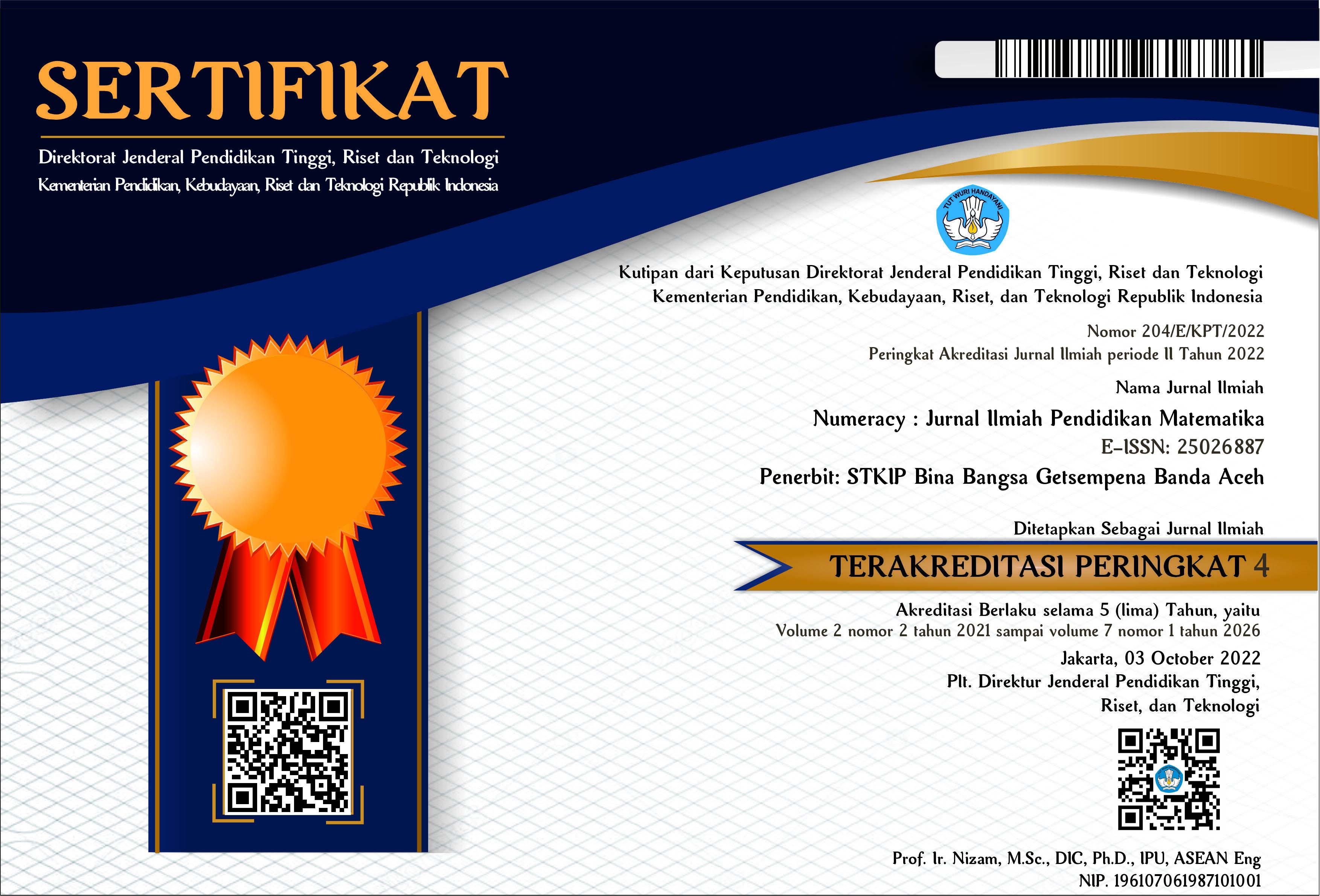KEMAMPUAN SISWA MENYUSUN SOAL PROBLEM SOLVING MELALUI PENDEKATAN PROBLEM POSING
Abstract
Problem solving skills are very important for every student to have. Students are still difficult to draw conclusions, understand problems, and provide reasons for the answers produced. One way to develop students' ability to solve problem solving problems is to get students to develop questions. When students make questions it is expected to understand the questions well. The strategy that can be used to familiarize students with developing questions is through the Problem Posing approach. The purpose of this study is to analyze the students' ability to develop problem solving questions. This study uses a qualitative approach with descriptive types. The subjects of this study were six students at Junior High School 3 Banda Aceh. Students 'ability in compiling problem solving questions is analyzed by categorizing the students' questions based on the type of difficulties that are seen from the structure of the language and the structure of mathematics. The results showed that students who meet the indicators understand the problem, make plans, carry out plans and check again, are able to make problems in terms of mathematical structures containing propositions to change, restate and vary, in terms of language structures containing presuppositions. Furthermore, students who meet the indicators understand the problem, make plans and implement plans, make the problems in terms of the mathematical structure containing propositions grouping and varying, in terms of the structure of the language containing the assignment propositions. The results also showed that students who met the indicators understood the problem and made a plan, were able to make the problem in terms of the mathematical structure containing the proposition restated and in terms of the language structure containing the assignment proposition.
Abstrak
Kemampuan pemecahan masalah sangat penting untuk dimiliki oleh setiap siswa. Siswa masih sulit untuk membuat kesimpulan, memahami permasalahan, dan memberikan alasan atas jawaban yang dihasilkan. Salah satu cara untuk mengembangkan kemampuan siswa menyelesaikan soal pemecahan masalah adalah dengan membiasakan siswa menyusun soal. Ketika siswa membuat soal diharapkan untuk memahami soal dengan baik. Strategi yang dapat digunakan untuk membiasakan siswa menyusun soal adalah melalui pendekatan Problem Posing. Tujuan dari penelitian ini adalah menganalisis kemampuan siswa dalam menyusun soal pemecahan masalah. Penelitian ini menggunakan pendekatan kualitatif dengan jenis deskriptif. Subjek penelitian ini adalah enam siswa pada SMP Negeri 3 Banda Aceh. Kemampuan siswa dalam menyusun soal pemecahan masalah dianalisis dengan mengkategorikan soal-soal yang dibuat siswa berdasarkan jenis kesulitannya yaitu dilihat dari struktur bahasa dan struktur matematika. Hasil penelitian menunjukkan bahwa siswa yang memenuhi indikator memahami masalah, membuat rencana, melaksanakan rencana dan memeriksa kembali, mampu membuat soal ditinjau dari struktur matematika memuat proposisi mengubah, menyatakan kembali dan memvariasikan, ditinjau dari struktur bahasa memuat proposisi pengandaian. Selanjutnya siswa yang memenuhi indikator memahami masalah, membuat rencana dan melaksanakan rencana, membuat soal ditinjau dari struktur matematika memuat proposisi mengelompokkan dan memvariasikan, ditinjau dari struktur bahasa memuat proposisi penugasan. Hasil penelitian juga menunjukkan bahwa siswa yang memenuhi indikator memahami masalah dan membuat rencana, mampu membuat soal ditinjau dari struktur matematika memuat proposisi menyatakan kembali dan ditinjau dari struktur bahasa memuat proposisi penugasan.
Kata Kunci: Menyusun Soal, Problem Posing, Problem Solving
References
Bell, Frederick H. (1978). Teaching and learning mathematics: in secondary schools. Second Printing. Dubuque, Iowa: Wm. C. Brown. Company.
Branca, N. A. (1980). Problem solving as a goal, process and basic skill. Virginia: NCTM Inc.
Brown, S. I & Walter, M. I. (1990). The art of problem (2nd ed). Hillsdale. New Jersey: Lawrence Erlbaum Associates.
English, L. D. (1997). Promoting a problem posing classroom. Teaching Children Mathematics Journal, 4(3), 172-179.
Miles, M.B., & Huberman, A.M. (1992). Analisis data kualitatif (Terjemahan oleh Tjetjep Rohendi Rohidi). Jakarta, Indonesia: Penerbit Universitas Indonesia.
Polya. (1973). How to solve it. USA: Princeton University Press, Priceton, New Jersey.
Silver, E.A., Cai, J. (1996). An analysis of aritmatic problem posing by middle school students. Journal for Research In Mathematics Education, 27(5), 521-539.
Suherman, Eman. (2003). Strategi pembelajaran matematika kontemporer. Bandung: JICA.
Suryanto. (1998). Problem posing dalam pembelajaran matematika. Dalam Seminar Nasional Upaya-upaya Meningkatkan Peran Pendidikan dalam Menghadapi Era Globalisasi. Program Pasca Sarjana IKIP Malang. 4 April 1998.
TIMSS Assesment. (2008). International association for the evaluation of educational achievement (IEA). Publisher: TIMSS & PIRLS International Study Center, Lynch School of Education. Boston College.



















